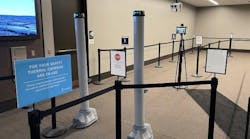FREDERICTON (CP) - Federal officials have installed Canada's first radiation detector at the port of Saint John in New Brunswick in a bid to protect this country against nuclear terrorism.
The Canadian Press has learned that while Saint John, N.B., is the first port to get the nuclear detection devices, all major Canadian ports soon will be equipped with the anti-terrorism technology.
''It is the first port in Canada to have the equipment up and running,'' Jennifer Morrison of the Canada Border Services Agency said Tuesday.
''It is designed to detect potential shipments of nuclear or radiological materials entering Canada.''
Morrison said details of the program will be released late next month.
The radiation detection program is a key part of Ottawa's $172-million plan to beef up marine security - all stemming from the terrorist attacks in the United States on Sept. 11, 2001.
The devices, which have been in use for two weeks in Saint John, detect radiation inside containers.
The detector is located on two large concrete columns. The containers are driven through the scanning portal after they have been loaded on trucks.
''The port has to be kept up to the same standards as other ports around the world,'' said Terry Wilson, a spokesman for unionized workers at the Saint John port.
''If we don't have these modern devices, we won't be able to compete.''
However, critics warn it is still not enough protection in an increasingly dangerous world.
Douglas Ross, a professor of political science at Simon Fraser University and an expert in the terrorist threat to North America, said the radiation detectors are just a first step and could be quickly outrun by terrorists intent on creating nuclear havoc.
''They're going for the first step,'' Ross said of Ottawa's port security system.
''That's better than no step, but they may be one step behind anybody who is seriously interested in trying to smuggle nuclear materials into the United States or Canada.''
Ross said Canada needs to seriously consider a more expensive, double-barreled protection system, employing not only radiation detection equipment but also X-rays that can reveal mysterious dark spaces inside containers.
He said those dark spaces could hide nuclear material that has been shielded from radiation detectors.
''They're looking for radiation and if something is really shielded, there will be no radiation and the stuff will get through'' Ross said.
''You need to X-ray all of the containers as well. If they were doing it simultaneously, using X-rays as well as radiation detectors, then we would be much better shape. But they are not doing the full x-ray of each container as they go through.''
He said several U.S. ports are already experimenting with more comprehensive detection systems.
The United States has had radiation detectors in effect for quite some time at its major ports.
''Some are up to 100 per cent screening,'' said Jarrod Agen, spokesman for Homeland Security in Washington. ''Our goal is to have as many ports as we can at 100 per cent screening.''
Ross said security experts believe it is a matter of when, not if, there is going to a nuclear terrorist attack in North America.
He said the threat for Canada is that this country could be used as a kind of nuclear test site for terrorists.
He said terrorists may detonate a device in Canada, or some other U.S. ally, to demonstrate their ability and threaten the Americans.
''A blackmail strategy is potentially a real risk,'' Ross said.
''We have to take this seriously.''
He said the advantages for terrorists are clear since the effects of a small yield nuclear blast in a place like Canada would be televised graphically and continuously for weeks and months across U.S. networks.
Ross said pressure from American public opinion could push the U.S. administration into conceding to terrorist demands.


